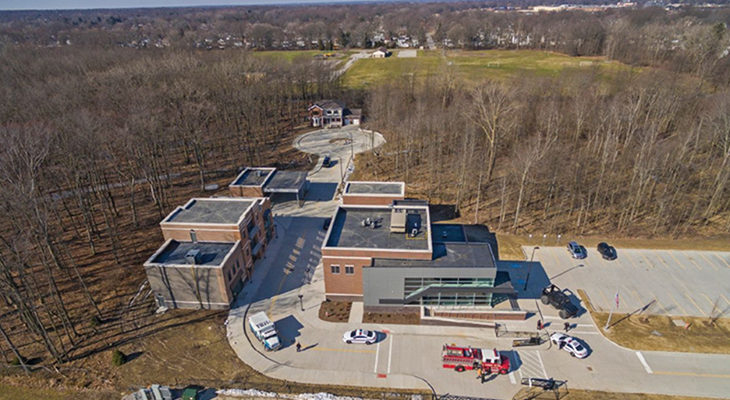
When classrooms are not enough: how higher education campuses can use immersive environments that replicate real-world situations to enhance public safety training. Featuring a case study of Cuyahoga Community College’s Simulated Scenario Village.
Today’s national conversation about law enforcement focuses on issues ranging from community-based policing to domestic terrorism and natural disasters. This proves the need for enhanced, realistic training for emergency responders, whether they be law enforcement professionals, firefighters, emergency medical technicians, or even social workers and military personnel.
Considering the complex demands on first responders, traditional classroom training can only go so far—that is why institutions like Cuyahoga Community College (Tri-C), Ohio’s oldest and largest community college system, are introducing “scenario-based training” programs and facilities. Current events have proven, now more than ever, the critical importance of providing immersive, lifelike training simulations for emergency response personnel so they can best serve the public. Additionally, first responder simulation training programs enable institutions to emerge as regional and national leaders in addressing these issues.
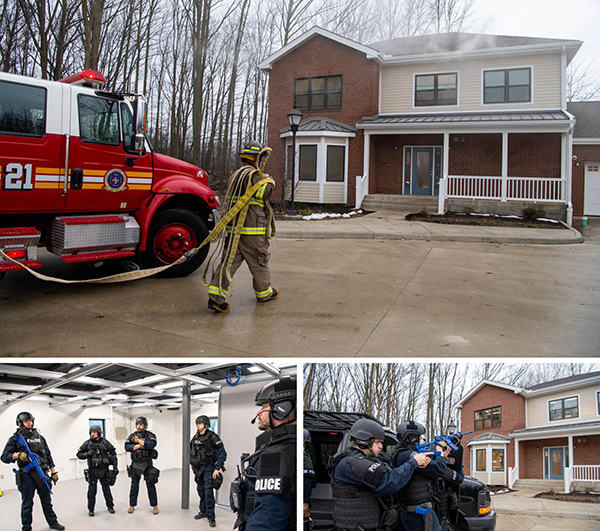
Tri-C had operated the Public Safety Training Center (PSTC) program on its Western Campus (Parma, Ohio) since 1982. In addition to hosting Tri-C police and fire service academies, PSTC supports first responders across a seven-county region in Northeast Ohio. The program also provides training for outside agencies such as the Cleveland Police Department, Ohio Station Highway Patrol, and the FBI.
In 2016, the college finished phase one of PSTC enhancements including a training building, indoor firing range, firehouse/training tower/burn building, and tactical driving courses. But the college still saw the need for additional “scenario-based training” to pair with classroom instruction. Trainees needed situations that they could encounter on the job in a realistic, yet safe setting.
John Lang, Tri-C’s former director of design, construction, and planning, said, “It has been demonstrated that trainees retain lessons at a higher level when they are conducted in a live-lab setting where controlled scenarios are designed to elicit responses and bring vital realism to the exercises.”
This need led to the creation of phase two: the Simulated Scenario Village, designed by Legat Architects as a public safety consultant to architect of record DS Architecture. The multi-facility site offers training for scenarios such as active shootings, hostage situations, domestic violence, missing persons, urban military operations, traffic stops, K-9, SWAT training, EMS training, and EMT/critical care. The village also enhances training in areas like K-9, self-contained breathing apparatus (S.C.B.A.), firefighter laddering/window extraction, firefighter smoke mazes, and the firefighter Candidate Physical Ability Test (C.P.A.T.).
Lang said, “The Simulated Scenario Village offers Tri-C the opportunity to provide immersive, integrated training for all kinds of emergency responders.”

More Voices Bring Better Spaces
A scenario-based training project with so few precedents demands the involvement of many players.
“Design for a project like this is not a simple process,” said David Potts of DS Architecture. “It gets messy. You have an idea and bring it into the mix. It gets morphed and refined, redirected, and changed. But if you have many voices at the table, everything comes out on the other end as a successful project.”
For the Tri-C Simulated Scenario Village, Legat and DS worked with local, state, and federal partners to identify best practices and to reimagine what the project could accomplish. Focus groups ranged from Tri-C training staff and the cities of Parma and Parma Heights to public safety agencies such as the Cleveland Division of Police, FBI, and Ohio Emergency Management Agency.
Stakeholder input led to several spaces not in the original program. These include a Multiple Laser Engagement System (MILES) within the exterior tactical village (original program had a “shoot house” using simulated paintball ammunitions), a 911 dispatch training room for the true “first responders,” a mat room for hand-to-hand subject control, an immersive firearms training simulator, and a prisoner cell training prop.
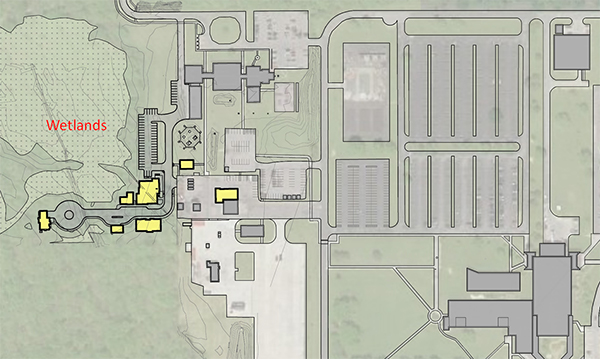
Wetlands and Streetscape: A View from Above
Initially seen as a hindrance, the wetlands area that borders the project site turned out to help define the buildings’ geometries. The wetlands also buffer the Simulated Scenario Village from the rest of the college—it would not have been effective to plunk these intensive training sessions in the middle of campus.
Watch the video below to get a flyover view of the project.
The village features a full streetscape similar to what one would encounter in towns across the nation. It includes several commercial buildings and ends in a cul-de-sac with a mock residence. Note in the video above the roofs used for training, the high parapets that act as guardrails, and the steps that lead to the roofs.
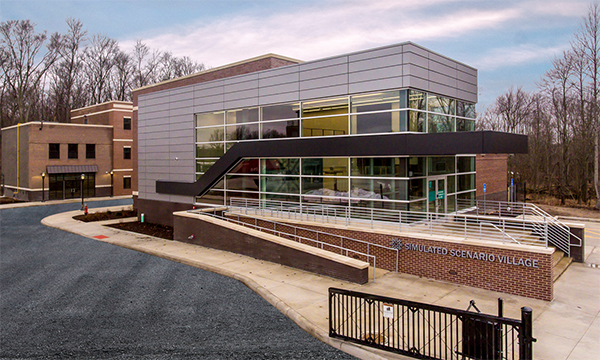
Training Center: Welcome, Safety, Storage
Institutions that incorporate a scenario-based first responder training program will benefit with a facility that serves as a headquarters. In the case of the Tri-C Simulated Scenario Village, the Training Center functions as the program hub.
According to David Potts, “The challenge for a facility like this is not only creating a welcoming atmosphere, but also prioritizing safety.”
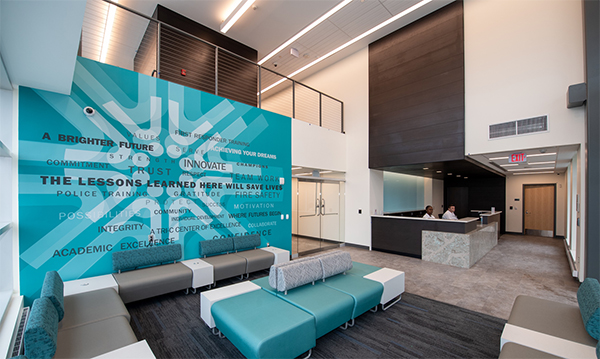
When users enter the Training Center lobby, they are greeted with a vibrant wall that features Tri-C’s teal color and logo, as well as words and phrases related to the Public Safety Center of Excellence. Additionally, a waiting area offers soft furniture selected based on the college’s color scheme.
To achieve the safety requirement, the facility requires members of all outside agencies to go through a secure entry and check their weapons before entering a training scenario.
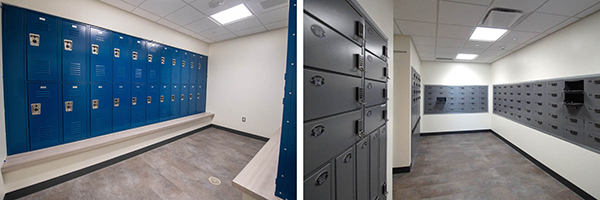
The main facility also offers much-needed storage. The Training Center includes lockers large enough to accommodate a variety of training gear, as well as weapons lockers so trainees can safely store both handguns and long guns before entering the tactical village. It also has storage for the Multiple Laser Engagement System.
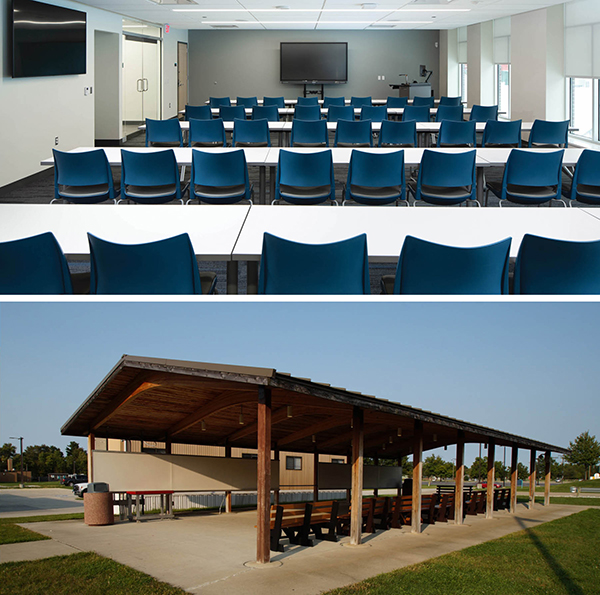
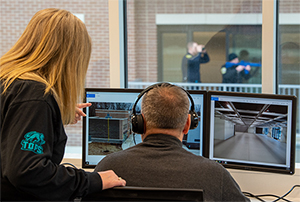
Recording and Debriefing
Another important consideration is whether the training facility offers the ability to record exercises so that trainees and instructors can debrief.
The Training Center houses a control room that enables monitoring of activity thanks to cameras and microphones located throughout the Simulated Scenario Village.
Both preparation and debriefing take place in a large, subdividable conference room or an outdoor pavilion.
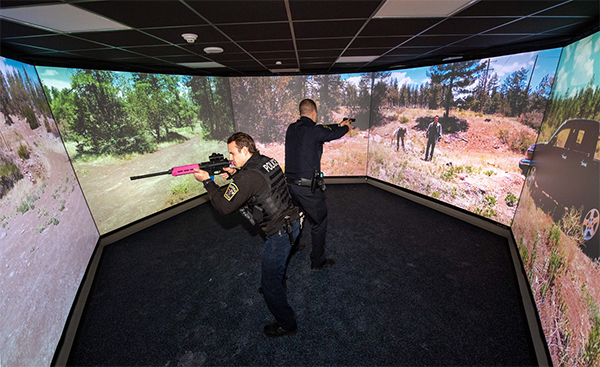
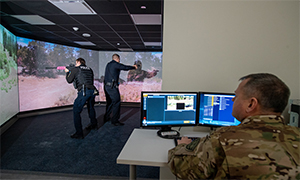
Controlled Emotions Mean Controlled Outcomes
According to Tri-C Basic Police Academy Director Jamie Tavano, when a call comes over the radio, officers have a physical reaction: heart rate elevates, breathing changes, hands sweat. Thus, simulated scenarios help teach trainees to control their emotions before controlling the situation for a successful outcome.
Tavano said, “The closer you can simulate real life, the more meaningful and responsive the training and the outcome of the training will be.”
Several examples of realistic settings are located on the Training Center’s lower level.
One of the most technologically advanced ways the Simulated Scenario Village achieves this training is the “VirTra” firearms training simulator that immerses trainees in 300-degree scenarios. An operator customizes the on-screen action with more than 150 different scenarios, each of which can be tailored with unique threats. This technology is particularly effective at building skills for communication and de-escalation.
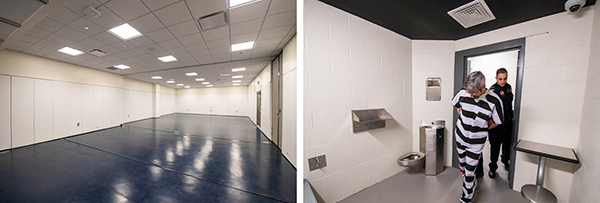
The Training Center’s lower level also has a subject control training room equipped with floor and wall mats, as well as a reconfigurable wall system in one corner. Using foam furniture, instructors can transform the space into a living room, bedroom, or office. Furniture adds realism and creates obstacles that trainees must navigate.
Next to the subject control room is the prisoner cell training prop, specifically suggested by local police departments. It meets Ohio standards and allows officers to practice a variety of techniques: safely entering the cell with an inmate, cell search, proper handcuffing, and more.
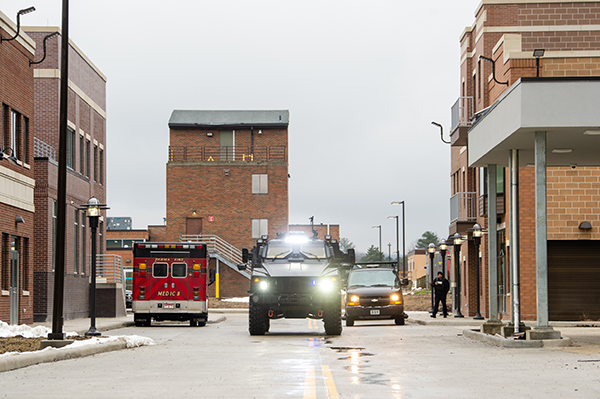
A Drive Through the Village
The thoroughfare that passes through the Simulated Scenario Village introduces a diverse collection of buildings that range in height from one to three stories. Instructors use an observation area on the Training Center’s roof to monitor drills or even as a potential high-level threat during a scenario. Other buildings have balconies and niches, enabling a greater variety of situations and places to hide. Various exterior stair configurations add to the flexibility. In one building, a fire escape-like stair leads to the roof.
One building offers a large canopy to mimic a drive-through at a bank or fast-food restaurant. It can also be used as a shelter during training exercises in bad weather. The street ends in a cul-de-sac with a family residence including a basement with a garden stair and a garage.
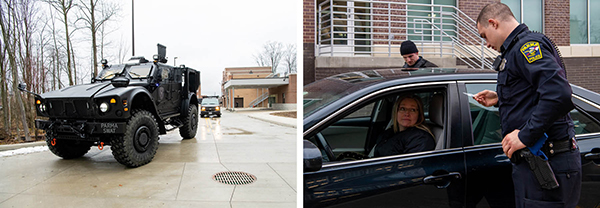
The streetscape also enables instructors to integrate vehicles into the exercises. Emergency responders, for instance, can learn to use vehicles as a shield or quickly remove life-saving equipment from ambulances. Additionally, the street gives police trainees authentic experience with one of the most dangerous aspects of job: traffic stops.
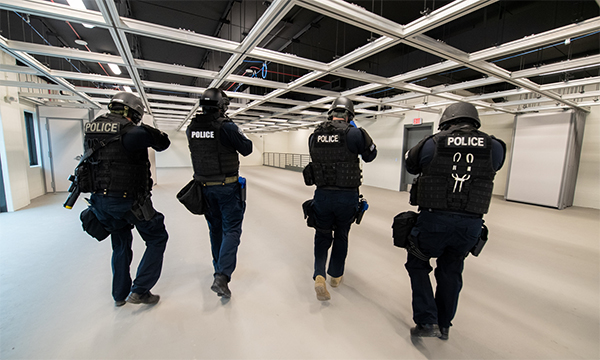
Reconfigurable Wall Systems
When it comes to indoor scenarios, it is critical that trainees do not get the same layout for each session. After all, that door on the left side in a repeated training scenario might be on the right side in a real-life situation. The Simulated Scenario Village facilities use a “Hufcor FlexTact” reconfigurable wall panel system. One person can quickly rearrange the panels to create completely different layouts. To add to the system’s flexibility, some panels are solid, while others have doors or windows.

Laser Tag on Steroids
According to Tavano, the introduction of outside stressors creates more realistic training scenarios. One example of a stressor is the theatrical smoke that instructors can add to a training session. Smoke-filled, maze-like exercises help both law enforcement and firefighter trainees practice everything from spider crawls to canine rescues.
To enhance the realism even more, instructors have trainees wear a “StressVest” that interacts with a Multiple Integrated Laser Engagement System. The system gives a small shock to a vest-wearing officer who gets hit by a laser shot. Tavano, who calls the system “laser tag on steroids,” says that when officers understand the possibility of a little pain, it puts them on high alert. Add to this the smoke, alarms, compromised lighting, and unfamiliar setting, and it creates a valuable learning opportunity.
Just Like the Real Thing
The need for well-prepared police officers, firefighters, emergency medical technicians, and other first responders has never been more important. Just as critical is that these professionals have places where they can train together and where they can get experiences as close as possible to those that they will encounter in the field. Cuyahoga Community College’s Simulated Scenario Village is one such place.
Lang said, “This level of immersive simulated scenario-type training doesn’t really exist between the East Coast and Chicago.”
In the coming decades, higher education providers and governmental agencies have an opportunity to enhance public safety by embracing these facility types.
Contact us to learn more about simulation and emergency responder design or comment below to share your thoughts on this post.
All photos courtesy Cuyahoga Community College.


